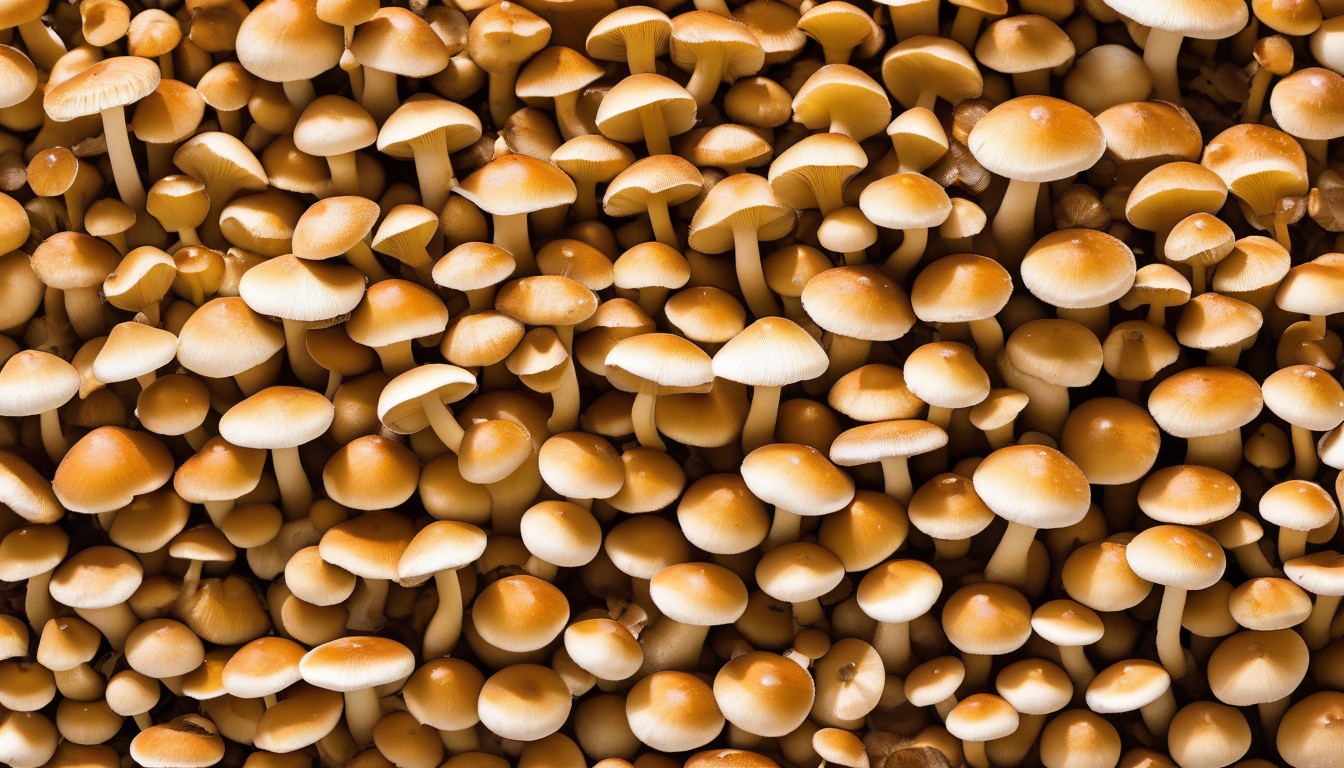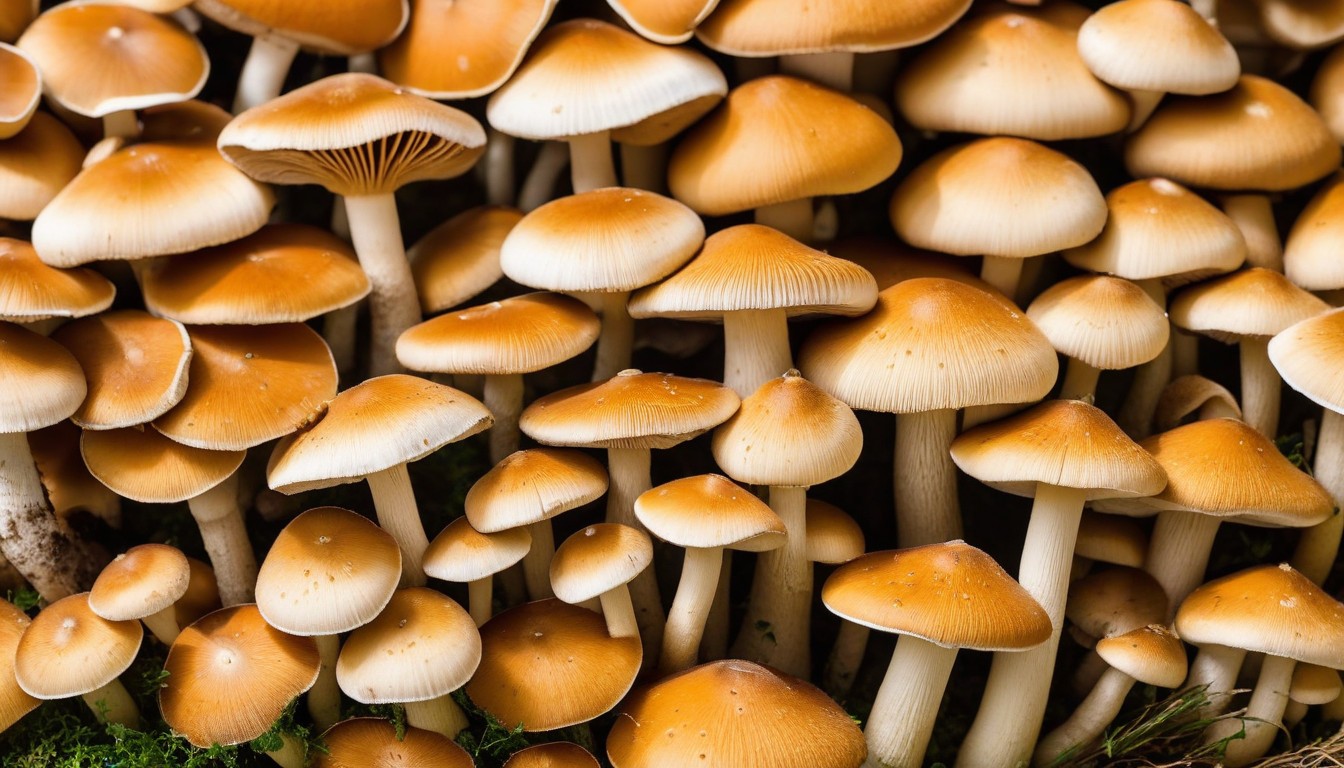If you’re looking to manage your blood sugar levels or simply make healthier choices, then mushrooms should definitely be on your list. These versatile, low-calorie, and nutrient-dense veggies have a low glycemic index, which means they won’t cause a significant spike in your blood sugar.
In this section, we’ll explore the diet-friendly facts surrounding the glycemic index of mushrooms, including their nutritional benefits, their role in blood sugar control, and different ways to incorporate them into a balanced diet.
Key Takeaways:
- Mushrooms have a low glycemic index, making them a great addition to a blood sugar-friendly diet
- They are nutrient-dense and packed with vitamins, minerals, and antioxidants
- Mushrooms can be used as a meat substitute in vegetarian and vegan dishes thanks to their unique texture and flavor
- There are many different types of mushrooms with varying glycemic index values, so it’s essential to know what you’re consuming
- With proper precautions, mushrooms can be a safe and healthy addition to any diet
What is the Glycemic Index?
Have you ever wondered why certain foods cause a spike in your blood sugar levels while others have little to no effect? The answer lies in the glycemic index (GI).
The GI is a measure of how quickly carbohydrates in food are broken down and converted into glucose, which then enters the bloodstream and affects blood sugar levels. Foods with a high GI value (above 70) cause blood sugar levels to rise rapidly, while foods with a low GI value (below 55) are slowly digested, causing a gradual rise in blood sugar levels.
Understanding the GI is crucial for managing diabetes and overall health, as it can help individuals make informed choices about their diet and manage their blood sugar levels. By incorporating more low GI foods into your meals, you can help maintain steady blood sugar levels, prevent energy crashes, and reduce your risk of developing chronic diseases.
How is the Glycemic Index Determined?
The GI of a food is determined by measuring the glycemic response of individuals to a specific amount of carbohydrates in that food, compared to their response to a standard food, usually glucose or white bread. The result is then expressed as a percentage or a number on a scale of 0 to 100, with glucose having a GI value of 100.
It is important to note that the GI value of a food does not necessarily reflect its nutritional value, as some low GI foods can still be high in calories, fat, or sodium. However, incorporating a variety of low GI foods into a balanced diet can help promote overall health and well-being.
The GI is a measure of how quickly carbohydrates in food are broken down and converted into glucose, which then enters the bloodstream and affects blood sugar levels.
The Benefits of Low GI Foods
Choosing low GI foods can provide numerous health benefits, such as improved blood sugar control, increased satiety, and reduced risk of chronic diseases, including type 2 diabetes, heart disease, and obesity. Low GI foods can also provide sustained energy and prevent energy crashes, which can be especially beneficial for athletes and active individuals.
Mushrooms are an excellent example of a low GI food that provides a range of health benefits. With a low GI value of 10-15, mushrooms have minimal impact on blood sugar levels, making them an ideal addition to a low GI diet. Mushrooms are also low in calories, high in fiber, and rich in vitamins and minerals, such as vitamin D, potassium, and selenium.
Stay tuned to learn more about the different types of mushrooms and their GI values in the next section.
Understanding the Glycemic Index Scale
The glycemic index (GI) scale categorizes foods based on their effect on blood sugar levels. It measures how quickly and dramatically a particular food raises blood sugar levels compared to pure glucose, which has a GI of 100.
Foods with a low GI value (less than 55) are considered healthier as they do not cause a sharp spike in blood sugar levels. Foods with medium GI values (56 to 69) are considered moderate, while foods with high GI values (70 or more) are known to cause a rapid increase in blood sugar levels, leading to a subsequent crash and hunger pangs.
Low GI Foods
|
Food |
GI Value |
|---|---|
|
Peas |
22 |
|
Broccoli |
15 |
|
Mushrooms |
10 |
|
Cherries |
22 |
Medium GI Foods
|
Food |
GI Value |
|---|---|
|
Brown Rice |
55 |
|
Whole Wheat Bread |
69 |
|
Barley |
28 |
|
Sweet potato |
63 |
High GI Foods
|
Food |
GI Value |
|---|---|
|
White Bread |
71 |
|
White Rice |
73 |
|
Pure Glucose |
100 |
|
Cornflakes |
81 |
Choosing foods with low GI values can help regulate blood sugar levels and prevent the onset of type 2 diabetes. Mushrooms, with their low GI value of 10, emerge as an excellent addition to any balanced diet plan, even for people who are prone to insulin resistance.
Mushrooms and Blood Sugar Control

Did you know that mushrooms can play a positive role in regulating blood sugar levels? With a low glycemic index, they can provide sustained energy throughout the day, perfect for those watching their blood sugar. The glycemic index measures how quickly foods increase blood sugar levels, and the lower the value, the slower the rise in blood sugar. Mushrooms have a glycemic index value less than 15, making them one of the best options for diabetic individuals.
“Mushrooms, as an addition to the diabetic meal, could contribute to a better glycemic control, promote weight loss, and reduce cardiovascular risk as it contains numerous beneficial substances and low calorie count.” – Dr. Mohammadreza Vafa, Diabetes and Metabolic Diseases Specialist
Moreover, the high fiber content in mushrooms slows down the absorption of glucose into the bloodstream, subsequently stabilizing blood sugar levels. Fiber also contributes to a feeling of fullness, helping prevent overeating and promoting weight management.
Mushrooms vs. Other Foods:
|
Food Category |
Glycemic Index Range |
|---|---|
|
Mushrooms |
0-15 |
|
Non-Starchy Vegetables |
0-55 |
|
Beans/Legumes |
10-60 |
|
Whole Grains |
30-70 |
|
Sugary Foods |
70 and above |
As the table shows, mushrooms and non-starchy vegetables have the lowest glycemic index, making them the best choice for those with blood sugar concerns. Including mushrooms in meals is an easy way to aid in blood sugar control and contribute to an overall healthy diet.
Types of Mushrooms and Their Glycemic Index Values

Mushrooms come in a variety of shapes, sizes, and colors, making them a versatile ingredient in many dishes. Understanding the glycemic index values of different types of mushrooms can help you make informed choices when planning your low-glycemic diet. Here are some common types of mushrooms and their glycemic index values:
|
Mushroom Type |
Glycemic Index Value |
|---|---|
|
White Button |
15 |
|
Cremini |
15 |
|
Portobello |
15 |
|
Shiitake |
40 |
|
Enoki |
32 |
|
Oyster |
15 |
|
Maitake |
0 |
As you can see, most varieties of mushrooms have a low glycemic index value of 15 or lower, making them an excellent choice for blood sugar control and sustained energy. However, it’s worth noting that shiitake and enoki mushrooms have slightly higher glycemic index values. Nonetheless, when consumed in moderation, mushrooms of all kinds can contribute to a balanced and healthy diet.
Incorporate different types of mushrooms into your meals to add variety and nutrition. Whether you prefer the earthy flavor of portobellos, the delicate texture of enokis, or the meaty taste of shiitakes, mushrooms are a flavorful and diet-friendly choice that can elevate any dish.
Nutritional Benefits of Mushrooms
Do you know that mushrooms are not only low in calories and carbohydrates but also packed with essential nutrients that promote health and vitality? Beyond their benefits for glycemic control, mushrooms contain a range of vitamins, minerals, and antioxidants that can support overall well-being.
|
Vitamins |
Minerals |
Antioxidants |
|---|---|---|
|
✓ Vitamin D |
✓ Potassium |
✓ Polyphenols |
|
✓ Vitamin B2 (Riboflavin) |
✓ Selenium |
✓ L-ergothioneine |
|
✓ Vitamin B3 (Niacin) |
✓ Copper |
✓ Glutathione |
|
✓ Folate |
✓ Phosphorus |
✓ Beta-glucans |
|
✓ Vitamin B5 (Pantothenic acid) |
✓ Zinc |
✓ Ergosterol |
Moreover, mushrooms are rich in fiber, which can promote digestive health and help regulate blood cholesterol levels. They also contain choline, an essential nutrient for brain function and development.
There are over 10,000 species of mushrooms, and each one has a unique nutritional profile. For instance, Shiitake mushrooms are a good source of iron, while Portobello mushrooms are rich in phosphorus and folate. By incorporating different types of mushrooms into your meals, you can diversify your nutrient intake and enjoy varied flavors and textures.
The best way to reap the nutritional benefits of mushrooms is to consume them regularly as part of a balanced diet that includes a variety of fruits, vegetables, whole grains, and healthy fats. Whether you sauté them as a side dish, incorporate them into stir-fries and stews, or use them as a meat substitute in burgers and sandwiches, mushrooms offer a delicious and nutritious way to support your health.
Cooking with Mushrooms for Healthy Eating

Mushrooms are a versatile ingredient that can add flavor, texture, and nutrition to a variety of meals and snacks. Incorporating mushrooms into your healthy eating plan is easy and delicious.
Here are some delicious and nutritious recipes to get you started:
|
Name of Recipe |
Description |
|---|---|
|
Mushroom and Spinach Stir-Fry |
A quick and healthy stir-fry made with sliced mushrooms, spinach, garlic, and soy sauce. Serve it over brown rice or quinoa for a complete meal. |
|
Mushroom and Egg Breakfast Skillet |
This protein-packed breakfast skillet is made with sliced mushrooms, onions, peppers, and scrambled eggs. Add some whole-grain toast on the side for a satisfying meal. |
|
Portobello Mushroom Burgers |
These vegetarian burgers are made with marinated portobello mushroom caps, grilled to perfection. Serve them on whole-grain buns with your favorite toppings. |
Other ways to enjoy mushrooms include adding them to salads, soups, omelets, and pizza. Get creative and experiment with different types of mushrooms, such as shiitake, cremini, and oyster.
By cooking with mushrooms, you can create healthy, delicious meals that are packed with flavor and nutrition.
Mushrooms as a Meat Substitute
For vegetarians and vegans, mushrooms offer the perfect alternative to meat. Not only do they contain important nutrients like potassium and vitamin D, but they can also provide a meaty texture and umami flavor that make them an excellent stand-in for many meat dishes. Mushrooms can be used in a variety of cuisines, from Asian stir-fries to Italian pasta dishes.
Some types of mushrooms, like portobello or shiitake, are particularly good meat substitutes due to their hearty texture and earthy flavor. Portobello mushrooms can replace a burger patty, and shiitake mushrooms can be added to stews or soups instead of beef.
When cooking with mushrooms as a meat substitute, it’s important to season them well and pair them with complementary ingredients. For example, adding fragrant herbs like thyme and rosemary can enhance their savory taste. Mushrooms can also be paired with grains like quinoa or brown rice for a complete protein source.
Comparison of Nutritional Content between Mushrooms and Beef (per 100g)
|
Mushrooms (raw) |
Beef (cooked) | |
|---|---|---|
|
Calories |
22 |
250 |
|
Protein |
3.1g |
26.1g |
|
Fat |
0.3g |
18.3g |
|
Sodium |
5mg |
70mg |
|
Iron |
0.7mg |
2.1mg |
As shown above, mushrooms are significantly lower in calories and fat than beef, making them a healthier option for those looking to cut down on meat consumption.
Adding mushrooms to your diet as a meat substitute can also have significant environmental benefits, as producing mushrooms requires fewer resources and generates less greenhouse gas emissions compared to meat production.
Whether you’re a vegetarian or simply looking to reduce your meat consumption, mushrooms offer a versatile and flavorful option for replacing meat in your diet.
Incorporating Mushrooms into a Balanced Diet

If you’re looking to improve your diet, adding mushrooms can be a smart choice. Here are some tips for incorporating mushrooms into a balanced diet:
- Portion sizes: A serving size of mushrooms is typically one cup, sliced. This can vary based on the recipe, but keep this in mind when planning your meals.
- Meal planning: Mushrooms can be a great addition to a variety of meals, from omelets to stir-fries. Try swapping out meat for mushrooms in your favorite recipes for a healthier twist.
- Dietary considerations: If you are following a specific dietary plan, such as low-carb or gluten-free, be sure to choose mushroom recipes that fit within your parameters.
Incorporating mushrooms into a balanced diet can provide a range of health benefits, including blood sugar control, increased nutrient intake, and improved overall well-being. Here’s a table showcasing the nutritional benefits of incorporating mushrooms into a balanced diet:
|
Nutrient |
Amount per 1 Cup Sliced Mushrooms |
|---|---|
|
Calories |
15 |
|
Protein |
2.2g |
|
Dietary fiber |
0.7g |
|
Vitamin B6 |
0.1mg |
|
Potassium |
223mg |
|
Phosphorus |
50mg |
|
Selenium |
8.2mcg |
|
Vitamin D |
2.3mcg |
As you can see from the table, mushrooms are a nutrient-dense food that can be beneficial for overall health.
Risks and Precautions with Mushrooms
While mushrooms are generally safe to eat, there are some risks and precautions to consider before consuming them.
- Allergies: Some individuals may experience an allergic reaction to certain types of mushrooms. Symptoms may include hives, itching, swelling, and difficulty breathing. If you suspect an allergic reaction, seek medical attention immediately.
- Drug interactions: Certain medications, such as blood thinners and chemotherapy drugs, may interact with compounds in mushrooms. It is important to consult with a healthcare provider before consuming mushrooms if you take any medication regularly.
- Wild mushrooms: Avoid eating wild mushrooms unless you are an expert at identifying edible species. Some wild mushrooms can be poisonous and cause serious health complications.
If you follow these precautions, you can enjoy the benefits of adding mushrooms to your diet without any health risks.
Conclusion
In conclusion, mushrooms are a valuable addition to any diet plan. With their low glycemic index, they offer a healthy alternative to high-carb foods that can lead to blood sugar spikes. They are also a rich source of vitamins, minerals, and antioxidants that contribute to overall health and well-being.
Whether you’re using them as a meat substitute, incorporating them into your recipes, or enjoying them as a snack, mushrooms offer a range of options for mindful eaters seeking a balanced diet.
However, it’s important to be aware of potential risks and precautions associated with consuming mushrooms. If you have allergies or are on certain medications, consult with your healthcare provider before adding mushrooms to your diet.
Incorporating mushrooms into your meals can be a fun and delicious way to achieve blood sugar control and a healthy lifestyle. Give them a try and see how they can enhance your diet!
FAQ
What is the glycemic index?
The glycemic index is a ranking system that measures the impact of different foods on blood sugar levels. It helps individuals understand how quickly and significantly certain foods can raise blood glucose levels.
How does the glycemic index scale work?
The glycemic index scale categorizes foods based on their impact on blood sugar levels. Low glycemic index foods have values below 55, medium glycemic index foods have values between 56 and 69, and high glycemic index foods have values above 70.
Can mushrooms help control blood sugar?
Yes, mushrooms can aid in blood sugar control due to their low glycemic index. They have minimal impact on blood glucose levels, making them a suitable choice for individuals managing diabetes or looking to regulate their blood sugar.
What are the different glycemic index values of various mushroom types?
Different mushroom types have varying glycemic index values. For example, white button mushrooms have a glycemic index of 10, shiitake mushrooms have a glycemic index of 10, and portobello mushrooms have a glycemic index of 15.
What are the nutritional benefits of mushrooms?
Mushrooms offer several nutritional benefits beyond their low glycemic index. They are a good source of vitamins, minerals, and antioxidants, including vitamin D, potassium, and selenium, which contribute to overall health and well-being.
How can I incorporate mushrooms into a balanced diet?
You can easily integrate mushrooms into a balanced diet by using them in various recipes and meal preparations. They can be added to salads, stir-fries, omelets, and pasta dishes, offering a flavorful and nutritious addition to your meals.
Can mushrooms be used as a meat substitute?
Yes, mushrooms can be an excellent meat substitute in vegetarian and vegan dishes. They have a unique texture and umami flavor that can enhance the taste and nutritional profile of meals, making them a versatile option for those looking to reduce meat consumption.
Are there any risks or precautions associated with mushrooms?
While mushrooms are generally safe to consume, there are a few considerations to keep in mind. Some individuals may be allergic to certain mushroom varieties, and certain medications may interact with certain compounds in mushrooms. It’s always best to consult with a healthcare professional if you have any concerns.

